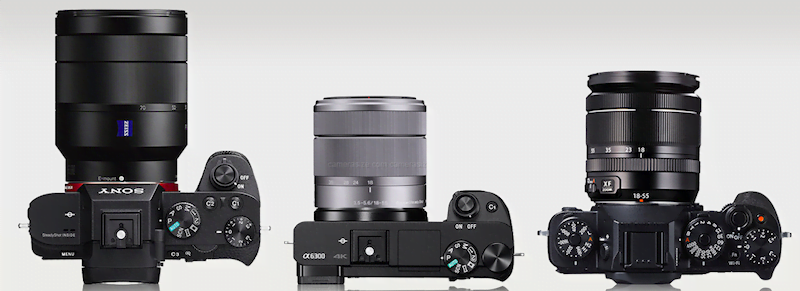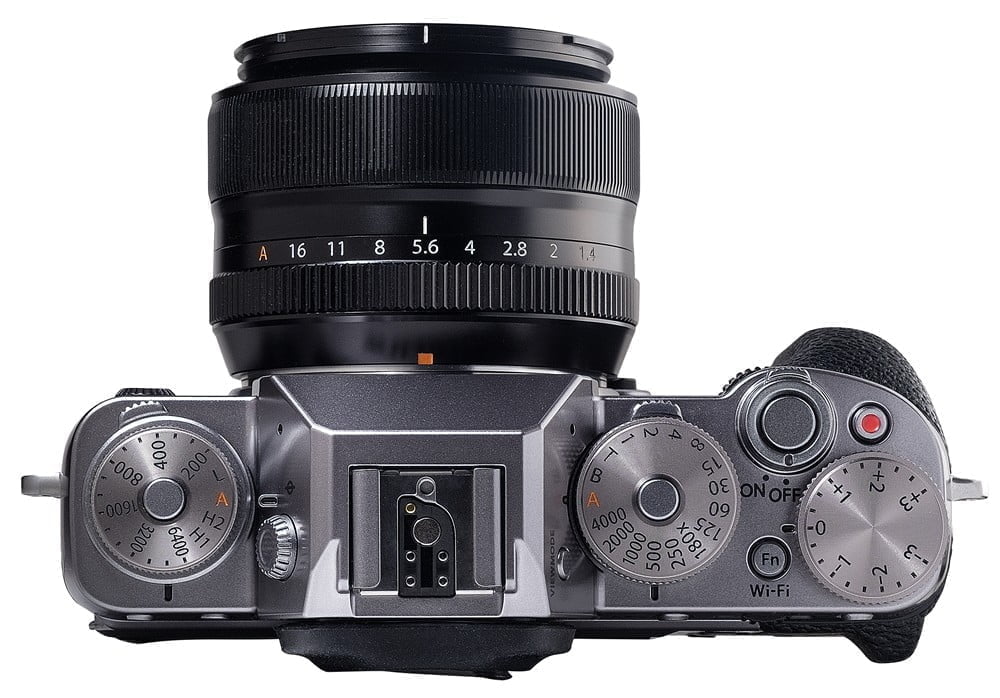Disclosure: This post may contain affiliate links. I earn a small commission of product sales to keep this website going.
Spoiler alert: despite what you may see on YouTube, there is no better camera, only better for you. And I’ve found that, compared to Sony, Fuji mirrorless cameras are better for me and I’ll discuss why below.
Related: Mirrorless Camera Comparisons from ALL Brands
Going mirrorless
In the 90s I was using an old Pentax 35mm; Fuji Velvia was my favorite film. When the digital revolution started, I stuck with Pentax and their *ist D series DSLRs. I eventually switched to Canon for their legendary lenses and was loyal to them for almost 10 years. Then a few years ago I sold off all of my Canon gear and became a full-time Sony shooter.
Reasons for switching to Sony mirrorless
I love to pack light. Sony’s a6000 was just as capable as the Canon 5DII for my purposes but at the fraction of the size & weight. This really appealed to someone preparing for a 210-mile backpacking trip.
Sony’s mirrorless cameras offered some amazing capabilities, top-end technology, and was quickly making waves amongst professional photographers. They had a limited lens selection at first, but the lenses they did offer were pretty good.
But after a couple of years, there were just some things that started to get to me: the cameras got bigger and heavier as they evolved, they started to feel more like computers than cameras, and they just seemed too fragile for what I was doing.
How Fujifilm is Different than Sony
I’m not going to go into the technical details that some of you may be looking for, like image comparisons or pixel density or anything like that. Those are largely superficial and invented in camera forums.
I’m going to discuss the “big picture” differences between Fujifilm and Sony, the ones that in my mind should matter.
Where I prefer Fujifilm vs Sony
Dials everywhere
Sony has notoriously awful menus. Like the worst I’ve ever seen. It’s as if they threw every available option in a bucket and then pulled things out at random. Not that Fujifilm menus are a lot better (they’re actually organized in a way that makes sense), but adjusting settings on a Fujifilm makes you feel like you’re operating a camera. This was super important to me, someone who grew up on an old Pentax.
You don’t have to navigate menus or program buttons to change common settings – they’re all knobs and switches on the Fuji cameras. It brings back the feel of an actual camera. You can see what your settings are just by glancing at the camera, and without turning the power on. Aperture, ISO, shutter, drive mode, focus mode, exposure compensation – it’s all there with tangible controls that show you what’s set.
Why is this important? We’re supposed to be making pictures, not operating a computer. Anything, no matter how small, that makes this endeavor more enjoyable is worth more than gold.
Weather sealing
The newer Sony cameras and the professional Fujifilm cameras are sealed, but Fujifilm does a better job of keeping the elements out of those sensitive electronics. Ideal for those who spend time in tough conditions.
On the Fujifilm vs Sony lenses too – my Sony lenses were quickly infiltrated with dust and I spent a good amount of time removing dust spots during post-processing. In fact, I spent more time doing this than anything else. Yes, I could have made a “dust map” and sent those lenses in for a cleaning after every trip, but that’s the thing. I shouldn’t have to be doing those things in the first place.
I’ve had my Fujifilm system much longer now, have taken it into more austere environments than I ever took my Sony cameras, and have yet to remove a single dust spot. Less to worry about.
On top of that, Fujifilm’s lenses are killer awesome. That Fujifilm 16mm f/1.4 – oh my God!
They stay small
The Fujifilm X Series cameras are, in size & weight, in between the Sony a6000 series and the a7 series cameras. But because of the APS-C sensor, the lenses are smaller than their full-frame counterparts for Sony cameras.
This size & weight savings are cumulative. Add up a smaller camera body, smaller lenses, a lighter tripod, get a smaller bag, and traveling just got a whole lot easier.

Firmware upgrades
Sony releases firmware updates only when they need to, to address a bug or new lens. Fujifilm releases firmware upgrades when they come out with new tech, improving camera capabilities. It’s an upgrade, not just an update. That’s cool. The cameras are better long-term investments.
Film simulations, customizable
When I was still deciding on Fuji vs Sony, I had heard that many professional Fujifilm photographers don’t even process their photos, thanks to Fujifilm’s film simulations included in their cameras. The JPG vs RAW discussion is best saved for another post, but these film simulations give you much more than Sony’s “Creative Control” menu. You can get classic film stocks, like my aforementioned Velvia.
You can further customize these film stocks, tweaking their contrast, color, and dynamic range. It gives you Lightroom-like presets within your camera, leaving less to process later on, ultimately saving you time.
The more time I spend perfecting my Fujifilm JPG workflow, the more time I’ve gained back by not having to process anything later on. More time for more important things, with equally beautiful photos.
But what about APS-C image quality versus full-frame?
You know what…at this point, it doesn’t really matter anymore.
With today’s technology, just about any major camera manufacturer is going to build a camera that will produce sharp images with great color, and the ability to make impressive recoveries in the shadows & highlights.
Sensor size is a moot point, an argument reserved for photographers who need to make up for other shortcomings by bragging about how they shoot full-frame only. I know amazingly successful photographers who only use Micro 4/3rds cameras, who will any day make a more impactful photo than photographers who say it’s all about sensor size.
You might notice subtle differences by zooming in to 100% and doing side-by-side comparisons, but that’s not how anyone you should care about views your photos. Your viewers care more about the content of the photo, not the pixel pitch. They won’t notice noise differences. They won’t notice slight dynamic range differences. Learn how to make better photos, and spend less time comparing specs.
And that’s not to say Fujifilm APS-C sensors are inferior, not at all. They’re still amazing. I can’t tell that I’m on an APS-C camera versus a full-frame camera. The shortcomings just aren’t there. Oh and that reminds me, Sony builds Fujifilm’s sensors to Fuji’s specifications.
What’s really important in a camera
For me, my Fujifilm vs Sony debate came down to user experience.
- Their retro-style controls and classic lenses are more photographer-friendly – I feel like I’m operating a camera, not a computer.
- The additional bump in environmental protection is important when traveling.
- The cameras “look older/cheaper” and help you blend in more (I’ve had numerous people say, “oh, film.”).
- The entire system will keep my kit more portable, enabling me to go further & faster.
Am I saying that Fujifilm is better than Sony? No. Only better for me. Based on everything written above, will it be better for you? Maybe not. And that’s fine, Sony still makes a great camera.
As of this March 2023 update, I’ve been with Fujifilm for almost six years now, and have been loving it more and more every day. I’m currently using the X-T5 as my primary body and the X-T30 II as a secondary/backup. And when I want to go completely covert, like on the street, I always have my X100V.
Click here for my Fujifilm Camera Comparison post.
If you’re still not sold on either Fujifilm or Sony, you can compare other mirrorless camera brands here.





Jon
Sunday 14th of January 2024
I was thinking of switching from Fujifilm to the OM-1. But that means giving up the fuji style and a nice 100-400mm. What totally bugs me is the OM-1 seems so right….until you try to buy a 4/5 star DECENTLY priced tele zoom. Zip all! I cannot believe it. A camera that receives really high praise and the only telephoto zoom that would handle the OM body costs £6700!!!!! Thanks Olympus but I’ll happily stick with my Fujifilm XT2 for now.
John Peltier
Monday 15th of January 2024
Wow that's an insane price for a M43 lens. I don't see any X to OM adapters either.
Mirrorless cameras: Fujifilm vs. Sony – Matt Blank
Friday 1st of April 2022
[…] has the appearance of a contemporary update to a vintage film camera, which is a nice touch. In general, many people […]
VB
Thursday 17th of February 2022
Thank you John for such great content. Does all this apply to video as well (Fuji v Sony)?
John Peltier
Thursday 17th of February 2022
Sony has always been the leader in video; I was never really into video while I used Sony. I started doing much more video after switching to Fujifilm and have always been happy with the results, mostly in the newer Fujifilm cameras. The older models felt like they only included video "cause they had to." Starting with like the X-T3 and X-T30 they're very capable though.
Thomas
Monday 4th of October 2021
Thanks for posting your thoughts. I totally agree with your conclusions regarding APS vs Full Frame. I also agree that the Sony menus are terrible. I have both Fuji and Sony and actually enjoy using the Fuji a lot more.
Thanks again.
Sony A7III VS Fuji X-mount Cameras - Lensguide.io
Monday 26th of April 2021
[…] On his blog, photographer John Peltier has a great quote that proves why some photographers prefer to shoot with a Fujifilm. “We’re supposed to be making pictures, not operating a computer,” he says in defense of the old-school dials and easy-to-find controls on the Fuji cameras. […]